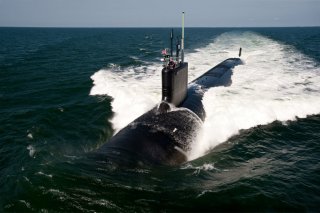The Great Virginia-Class Sub Delay
The Virginia-class submarines, currently being built by Huntington Ingalls Industry’s Newport News Shipbuilding (HII), are running far behind schedule. How will the affect American naval performance?
The Virginia-class submarines are facing construction delays and are now years behind schedule, complicating the Navy’s ability to field much-needed submarines. Consider the USS Massachusetts (SSN-798), the twenty-fifth Virginia-class submarine, which was scheduled to enter service sometime in late 2024, but now won’t see service until 2025.
The Massachusetts is a Block IV Virginia submarine, which is currently about three years behind schedule.
Construction Delays Causing Setbacks
Part of the scheduling problem is that only two shipyards can build a U.S. Navy submarine. Huntington Ingalls Industry’s Newport News Shipbuilding (HII), where the Massachusetts is being built, is one. When HII needed to replace certain equipment used in the construction process, the entire Virginia schedule was disrupted.
“During the quarter, SSN-798 construction team experienced a minor disruption to Massachusetts’ test program due to some equipment replacement identified during testing,” HII CEO Chris Kastner said last August. “We’re marching towards delivery on 798. We did have that minor move on the milestone, but they’re making progress on the test program now. And it’s a good team on it. It’s a good crew. It’s a good leadership. So I fully expect 798 will resolve at the beginning of next year.”
Indeed, HII is making progress. The Massachusetts was recently transferred from a construction facility to a floating dry dock where the final outfitting, final testing, and final crew certification processes began. Once completed, hopefully sometime in early 2025, the submarine will be given to the Navy.
Still, the scheduling delays are not limited just to Massachusetts; the USS Arkansas (SSN-800) is also running behind schedule.
A Heavy Investment
The delays on the Virginia-class are especially disheartening given how much the Navy has invested in the new submarines. For each Virginia carrying the Virginia Payload Module (VPM), which allows the submarine to carry more ordnance, the Navy is paying $4.3 billion.
The Navy is hoping the investment will be worthwhile, as Virginia is the newest fast attack submarine in the fleet and is slated to perform a wide variety of missions both in the open ocean and in the littorals. The Virginia is replacing the long-serving and venerable Los Angeles-class, which has already begun to be retired from the fleet.
The Virginia is expected to be delivered through the early 2040s, and expected to serve as late as 2070. So, Virginia is very crucial to the future force structure of the U.S. Navy at a time when the Navy is expected to take on a more prominent role in U.S. grand strategy, thanks to the rise of China and the importance of the Indo-Pacific region to U.S. interests.
The Virginia is expected to help mitigate the intermediate-range missile advantage that China currently enjoys over the U.S. The VPM system, which will allow the Virginia to carry more firepower than earlier non-VPM versions of the submarine, will serve to further mitigate the missile gap.
Harrison Kass is a defense and national security writer with over 1,000 total pieces on issues involving global affairs. An attorney, pilot, guitarist, and minor pro hockey player, Harrison joined the US Air Force as a Pilot Trainee but was medically discharged. Harrison holds a BA from Lake Forest College, a JD from the University of Oregon, and an MA from New York University. Harrison listens to Dokken.
Image Credit: Creative Commons and/or Shutterstock.

